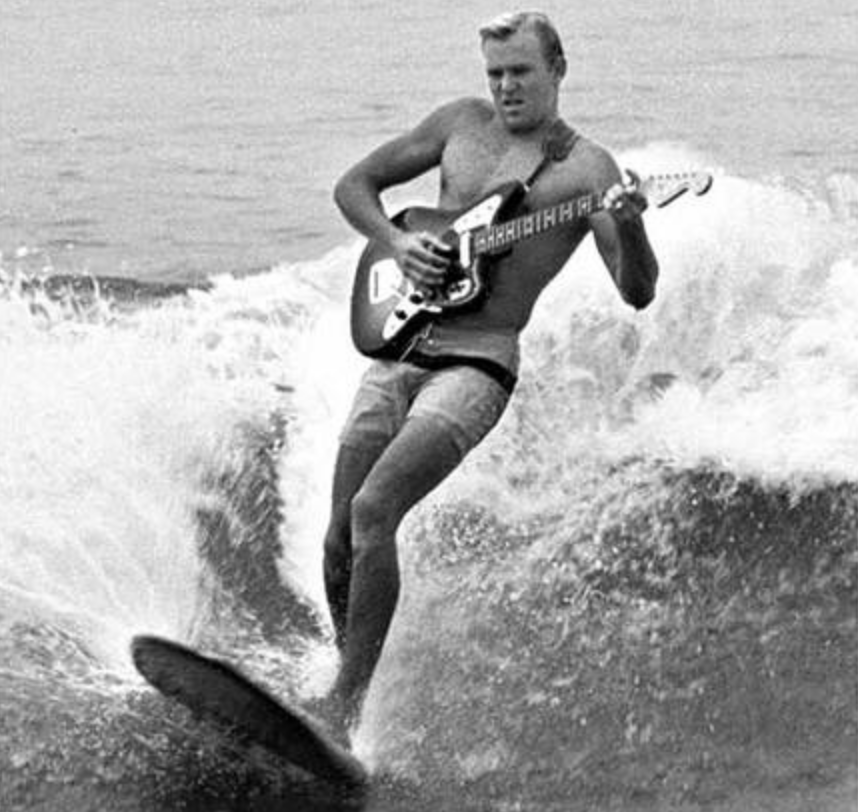Are you ready to get deep in the barrel? If you’re a fan of Dick Dale, Duane Eddy, the Ventures, or even the Beach Boys, Jason Loughlin has prepared 10 essential surf etudes in his new course Essentials: Surf Guitar. Jason will take you through the sounds of the 60’s up to the new age speckled surf sounds of The Aqua Velvets in the 80’s and the punk surf band Man or Astro-man? from the 90’s.
For these free surf guitar lessons, we’ll sample The Ventures for “Sand Flea” and exotica inspired by the sounds of Hawaii with “Forbidden Village”. And, if you’re still craving more gnarly surf guitar riffs, check out the full course on TrueFire! Let’s catch a wave!
Sand Flea: Overview
Though improvisation isn’t common in surf music, it does happen. This is an Aquarium Solarium tune I wrote that’s inspired by the later Ventures records. Improvisation became more common in the later Ventures records when they were covering country, R&B, and other popular styles. It’s also inspired by the guitarist Billy Strange’s records.
Sand Flea: Performance
Download the tab, notation, and jam track for the surf guitar lesson on TrueFire.
For “Sand Flea”, we have a twist beat and a bass ostinato similar to Ray Charles’ “What I’d Say”. We start in A minor with a vamp and then modulate C# major to start the head. The head is played over a 12 bar C# blues progression. After playing the head, we’ll solo using the minor pentatonic, blues scale, double stops, and occasionally targeting chord tones.
Sand Flea: Breakdown
In this study, we start playing the bass ostinato and then jump to the farfisa organ figure using double stops. Stealing organ ideas when soloing in this style always sounds good. The head starts at the modulation to C# major. Over the I chord, I’m playing double stop out of common major bar chord shapes. The IV chord template is a dom9th chord. I’m arpeggiating through this chord and alternating between the sus4 and the 3rd.
For my turnaround, I’m using the minor pentatonic. The solo for this tune only uses two positions on the guitar. I’m using the C# minor pentatonic scale, C# blues scales, and double stops based off the C# minor, F# major, and C# major chord shapes.
Forbidden Village: Overview
Martin Denny is known as the father of exotica and the soundtrack of Tiki Culture. He developed his sound playing in the Shell Bar of the famous Hawaiian Village in the mid 50’s. Along with contemporary Les Baxter, they pulled exotic rhythms and melodies from many cultures.
Exotica has always been a sister genre to surf music. Martin also had a knack for rearranging popular music of the day in really imaginative ways. The use of vibraphone, celeste and tropical bird noises created a dreamy ocean landscape.
Forbidden Village: Performance
Download the tab, notation, and jam track for this surf guitar lesson on TrueFire.
Harmonically, Martin Denny had a very unique style. There’s a lot of chromatic movement in the chords and a lot of added color by using major 7ths, b5ths, 6ths, and augmented chords.
This study is in E and has two sections: The first is over a I-V-I-IV-I-V-I progression. Seems simple, but by adding 6th/9ths to the major chords, altering each dom 7th chord, and chromatically moving chords to follow the melody, it quickly becomes complex, lush, and beautiful. The second section has the chromaticism built into the progression. We’re moving major chords up and down half steps and finding a melody to connect them. All this is done over a slower Mozambique rhythm.
Forbidden Village: Breakdown
This tune starts off with an E6/9 chord and then adds the major 7th. We’ll walk this down to a Baug7 and back to E. I’m altering the IV chord by adding a dom7 and b5. Next, I’m following the melody with the major chord shape. This brings the chord up to F, so when I add the B to the chord we get a Lydian sound.
The turnaround can be looked at a couple ways. You can see it as Gaug7 to B7 or look at Gaug7 as an inversion of an altered B7. If we were to think of it relating to B7, it would be spelled from bottom to top: b5, Root, 3rd, and #5. The second section starts on an Eb major chord. This is the beginning of a chromatic progression to goes as follows: Eb, E6, Eb+, E6, F, E, Eb, D, and Emaj7. Everything with the exception of the last chord is a half step away from each other. The trick is finding a melody that helps connect them in a way that makes it less obvious.
If you still haven’t wiped out and are hangin’ ten with Jason, make sure to check out the full Essentials: Surf Guitar course on TrueFire! There you’ll find 8 more surf etudes with tab, notation, and jam tracks to help you on your way. Cowabunga!
